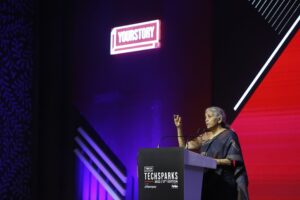Earlier this week, Zoho Corporation invested about $2.6 million (Rs 20 crore) in Thiruvananthapuram-based robotics company GenRobotics Innovation—making it the software firm’s seventh investment in Indian startups.
“Nurturing a thriving deeptech ecosystem in India is one of Zoho’s priorities and the investment in GenRobotics is a continuation of that commitment,” Sridhar Vembu, Founder and CEO, Zoho, said in a release.
The funding into GenRobotics followed Zoho’s investment of $5 million in Bengaluru-based Voxelgrids. Over the years, the unicorn has also invested nearly $10 million across five deeptech startups.
The Chennai-based firm’s story is also the story of its founder, who built a multi-million dollar company after turning down venture capital money and bootstrapping it all the way through.
Now in its 27th year, Zoho is a $690 million revenue company, with more than 75 million users.
The origins
Zoho was founded by Sridhar Vembu, Tony G Thomas, and Sreenivas Kanumuru. “All we know about Zoho Corp is that we were born sometime between late 1995 and early 1996,” Sridhar had written in a blogpost about a year ago.
“Back in 1995, we asked ourselves why India produces so much talent for export but could not build a home-grown technology powerhouse. That was the motivation to start the company,” Sridhar tells YourStory in an email.
“But as a bootstrapped company, our very concrete problem statement was ‘figure out how to survive in business’,” he adds.
In 1996, Tony, Sridhar’s senior in college, was working on a SNMP internet protocol software in Silicon Valley and needed somebody to help him sell it to customers. This is when he teamed up with Sridhar.
Sridhar joined Zoho–then Advent Network Management–to staff a booth Tony had rented in a trade show, as a salesman.
Sridhar Vembu
In 1997, the company made about $350,000 in sales, putting it all back in the R&D unit in Chennai, India.
This is when Sridhar and his team were convinced that Advent was a “real business”. Until then, the founders weren’t paying themselves salaries–something Sridhar equated business with.
“Customers were actually willing to pay for our product! We found a niche market where customers needed us,” Sridhar says.
By 1998, Advent crossed $1 million in sales, and doubled it the next year.
“The market opportunity was small but it was enough to feed us and let us fight another day. That small market taught us how to build a product, how to find customers, how to make a sale, how to support the customer and how to make a small profit doing all of that,” he says.
Sridhar had declined an offer from a venture capital firm in 1999, turned off by a clause that mandated liquidity or an initial public offering in the next eight years.
“The philosophy of taking somebody’s money and promising them what they want looks like a gamble to me. So, like a good man, I said no to the money,” Sridhar told YourStory in a previous interview.
Coming back stronger
By 2000, Sridhar took on the role of CEO and the company was on track to make $10 million in annual revenues—until they came face to face with the dotcom bust in 2001.
“Business pretty much dried up,” Sridhar had written. “It was obvious to me that the telecom market was not going to come back and all our revenue was from that market.”
Sridhar, along with his team, worked on a pivot to survive. The company worked to bring out new products, including IT management product ManageEngine and its cloud division Zoho.com, which were launched in 2002 and 2005, respectively.
Zoho also picked up the Zoho.com domain, originally belonging to a former US-based hospitality startup, for $5,000 in 2002.
Through the years, the company launched several software-as-a-subscription products, for which businesses would pay a certain fee for a year.
It launched one of its most popular products, a customer relationship management (CRM) software—Zoho CRM—in November 2005. This was followed by several other products such as Mail, Writer, Sheet, Show, Creator, Docs, and Meeting—which put it in competition with some of the leading software giants across the world.
Having built a lot more products, entered bigger markets and found a lot more customers in successive years, Advent was rebranded as Zoho Corporation in 2009.
It presently offers a suite of software to run businesses with four divisions: Zoho, ManageEngine, Qntrl—a workflow orchestration software, and training platform TrainerCentral.
Over the years, Zoho has amassed customers, including giants like Amazon, Philips, Godrej, OnePlus, Renault, Ola, and Hotstar.
Today, Zoho is a profitable company with a profit of Rs 1,917.72 crore in the financial year (FY) 2021, growing about 140 percent over the last year, as per its filings with the Registrar of Companies.
Its revenue from operations was Rs 5,229.65 crore during FY2021, up 22.3 percent from the year before.
The company employs more than 10,000 people, with offices in the United States, India, Japan, China, Singapore, Mexico, Australia, the Netherlands, and the United Arab Emirates.
Zoho says it is continuing to invest heavily in long-term R&D projects, and aggressively pursuing rural expansion, to create jobs where they are most needed.
“Our fundamental philosophy of business remains the same, but I do expect fairly serious turbulence ahead for the global economy which may necessitate course corrections,” Sridhar adds.

![You are currently viewing [The Turning Point] How Sridhar Vembu-led Zoho came back stronger after dotcom burst](https://blog.digitalsevaa.com/wp-content/uploads/2022/05/MalvikaCopyofImageTagging88-1653727945479.png)








